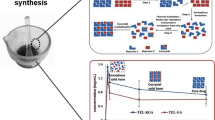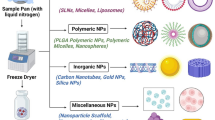Abstract
Several authors have studied the release profile of drugs incorporated in different devices. However, to the best of our knowledge, although many studies have been done on the release of tetracycline, in these release devices, no study has investigated if the released compound is actually the tetracycline, or, instead, a degraded product. This approach is exploited here. In this work, we analyse the influence of two drying methods on the tetracycline delivery behaviour of synthesised glasses using the sol-gel process. We compare the drying methods results using both theoretical models and practical essays, and analyse the chemical characteristic of the released product in order to verify if it remains tetracycline. Samples were freeze-dried or dried in an oven at 37°C and characterised by several methods such as Fourier transform infrared spectroscopy (FTIR), scanning electron microscopy (SEM), thermogravimetric analysis (TG), differential thermogravimetric analysis (DTG), differential thermal analyses (DTA) and gas adsorption analysis (BET). The released concentration of tetracycline hydrochloride was studied as a function of time, and it was measured by ultraviolet spectrophotometry in the tetracycline wavelength. The drug delivery profiles were reasonably consistent with a diffusion model analysis. In addition, we observed higher release rates for the freeze-dried compared to those dried in an oven at 37°C. This higher release can be attributed to larger pore size for the freeze-dried sample systems with tetracycline, which promoted more water penetration, improving the drug diffusion. The analysis of the solution obtained in the release tests using high-performance liquid chromatography- mass spectrometry (HPLC-MS) confirmed that tetracycline was being released.








Similar content being viewed by others
References
Soundrapandian C, Sa B, Datta S. Organic–inorganic composites for bone drug delivery. AAPS PharmSciTech. 2009;10(4):1158–71. https://doi.org/10.1208/s12249-009-9308-0.
Andrade AL, Manzi D, Domingues RZ. Tetracycline and propolis incorporation and release by bioactive glassy compounds. J Non-Cryst Solids. 2006;352(32-35):3502–7. https://doi.org/10.1016/j.jnoncrysol.2006.03.083.
Andrade AL, Souza DM, Vasconcellos WA, Ferreira RV, Domingues RZ. Tetracycline and/or hydrocortisone incorporation and release by bioactive glasses compounds. J Non-Cryst Solids. 2009;355(13):811–6. https://doi.org/10.1016/j.jnoncrysol.2009.01.015.
Wong TW, Colombo G, Sonvico F. Pectin matrix as oral drug delivery vehicle for colon cancer treatment. AAPS PharmSciTech. 2011;12(1):201–14. https://doi.org/10.1208/s12249-010-9564-z.
Carvalho JP, Santos AS, Sa AS, Teixeira CS, Nogueira MS. Estabilidade de medicamentos no âmbito farmacológico. Rev Farm Med. 2005;34:22–7.
Frenning G, Tunon A, Alderborn G. Modelling of drug release from coated granular pellets. J Control Release. 2003;92(1-2):113–23. https://doi.org/10.1016/S0168-3659(03)00300-6.
Arifin DY, Lee LY, Wang CH. Mathematical modeling and simulation of drug release from microspheres: implications to drug delivery systems. Adv Drug Deliv Rev. 2006;58(12-13):1274–325. https://doi.org/10.1016/j.addr.2006.09.007.
Siepmann J, Karrout Y, Gehrke M, Penz FK, Siepmann F. Predicting drug release from HPMC/lactose tablets. Int J Pharm. 2013;441(1-2):826–34. https://doi.org/10.1016/j.ijpharm.2012.12.009.
Juncu G, Stoica-Guzun A, Stroescu M, Isopencu G, Jinga SI. Drug release kinetics from carboxymethylcellulose-bacterial cellulose composite films. Int J Pharm. 2016;510(2):485–92. https://doi.org/10.1016/j.ijpharm.2015.11.053.
Narasimhan B, Langer R. Zero-order release of micro- and macromolecules from polymeric devices: the role of the burst effect. J Control Release. 1997;47(1):13–20. https://doi.org/10.1016/S0168-3659(96)01611-2.
Burgos AE, Belchior JC, Sinisterra RD. Controlled release of rhodium (II) carboxylates and their association complexes with cyclodextrins from hydroxyapatite matrix. Biomaterials. 2002;23(12):2519–26. https://doi.org/10.1016/S0142-9612(01)00386-6.
Reis MAA, Sinisterra RD, Belchior JC. An alternative approach based on artificial neural networks to study controlled drug release. J Pharm Sci. 2004;93(2):418–30. https://doi.org/10.1002/jps.10569.
Kokubo T, Kushitani H, Sakka S, Kitsugi T, Yamamuro T. Solutions able to reproduce in vivo surface-structure changes in bioactive glass-ceramic A–W3. J Biomed Mater Res. 1990;24(6):721–34. https://doi.org/10.1002/jbm.820240607.
Blanchflower WJ, McCracken RJ, Haggan AS, Kennedy DG. Confirmatory assay for the determination of tetracycline, oxytetracycline, chlortetracycline and its isomers in muscle and kidney using liquid chromatography mass spectrometry. J Chromatogr B. 1997;692(2):351–60. https://doi.org/10.1016/S0378-4347(96)00524-5.
Vartanian VH, Goolsby B, Brodbelt JS. Identification of tetracycline antibiotics by electrospray ionization in a quadrupole ion trap. J Am Soc Mass Spectrom. 1998;9(10):1089–98. https://doi.org/10.1016/S1044-0305(98)00078-6.
Lambs L, Decocklereverend B, Kozlowski H, Berthon G. Metal ion-tetracycline interactions in biological-fluids. 9. Circular-dichroism spectra of calcium and magnesium complexes with tetracycline, oxytetracycline, doxycycline, and chlortetracycline and discussion of their binding modes. Inorg Chem. 1988;27(17):3001–12. https://doi.org/10.1021/ic00290a022.
Desiqueira JM, Carvalho S, Paniago EB, Tosi L, Beraldo H. Metal-complexes of anhydrotetracycline. 1. A spectrometric study of the Cu(II) and Ni(II) complexes. J Pharm Sci. 1994;83:291–5. https://doi.org/10.1002/jps.2600830306.
Machado FC, Demicheli C, Garnier-Suillerot A, Beraldo H. Metal-complexes of anhydrotetracycline. 2. Absorption and circular-dichroism study of Mg(II), Al(III), and Fe(III) complexes Possible influence of the Mg(II) complex on the toxic side-effects of tetracycline. J Inorg Biochem. 1995;60(3):163–73. https://doi.org/10.1016/0162-0134(95)00017-I.
Matos SVDM, Beraldo H. Metal-complexes of anhydrotetracycline. 3. An absorption and circular-dichroism study of the Ni(II), Cu(II) and Zn(II) complexes in aqueous-solution. J Braz Chem Soc. 1995;6(4):405–11. https://doi.org/10.5935/0103-5053.19950069.
Mennucci B, Tomasi J, Cammi R, Cheeseman JR, Frisch MJ, Devlin FJ, et al. Polarizable continuum model (PCM) calculations of solvent effects on optical rotations of chiral molecules. J Phys Chem A. 2002;106(25):6102–13. https://doi.org/10.1021/jp020124t.
Becke AD. Density-functional exchange-energy approximation with correct asymptotic-behavior. Phys Rev A. 1988;38(6):3098–100. https://doi.org/10.1103/PhysRevA.38.3098.
Becke AD. Density-functional thermochemistry. 3. The role of exact exchange. J Chem Phys. 1993;98(7):5648–52. https://doi.org/10.1063/1.464913.
Lee C, Yang W, Parr RG. Development of the colle-salvetti correlation-energy formula into a functional of the electron-density. Phys Rev B. 1988;37(2):785–9. https://doi.org/10.1103/PhysRevB.37.785.
Godbout N, Salahub DR, Andzelm J, Wimmer E. Optimization of gaussian-type basis-sets for local spin-density functional calculations. 1. Boron through neon, optimization technique and validation. Can J Chem. 1992;70(2):560–71. https://doi.org/10.1139/v92-079.
Langer RS, Wise DL. Medical applications of controlled release, vol. I. Boca Raton: CRC-Press; 1984. p. 42–65.
Marquardt DW. An algorithm for least-squares estimation of nonlinear parameters. J Soc Ind Appl Math. 1963;11(2):431–41. https://doi.org/10.1137/0111030.
Wlosnewski JC, Kumpugdee-Vollrath M, Sriamornsak P. Effect of drying technique and disintegrant on physical properties and drug release behavior of microcrystalline cellulose-based pellets prepared by extrusion/spheronisation. Chem Eng Res Des. 2010;88(1):100–8. https://doi.org/10.1016/j.cherd.2009.07.001.
Gomez-Carracedo A, Souto C, Martinez-Pacheco R, Concheiro A, Gomez-Amoza JL. Microstructural and drug release properties of oven-dried and of slowly or fast frozen freeze-dried MCC-Carbopol® pellets. Eur J Pharm Biopharm. 2007;67(1):236–45. https://doi.org/10.1016/j.ejpb.2007.01.006.
Song B, Rough SL, Wilson DI. Effects of drying technique on extrusion–spheronisation granules and tablet properties. Int J Pharm. 2007;332(1-2):38–44. https://doi.org/10.1016/j.ijpharm.2006.09.050.
Jalvandi J, White M, Truong YB, Gao Y, Padhye R, Kyratzis IL. Release and antimicrobial activity of levofloxacin from composite mats of poly(ɛ-caprolactone) and mesoporous silica nanoparticles fabricated by core–shell electrospinning. J Mater Sci. 2015;50(24):7967–74. https://doi.org/10.1007/s10853-015-9361-x.
Tan JM, Karthivashan G, Abd Gaani S, Fakurazi S, Hussein MZ. In vitro drug release characteristic and cytotoxic activity of silibinin-loaded single walled carbon nanotubes functionalized with biocompatible polymers. Chem Cent J. 2016;10(1):81. https://doi.org/10.1186/s13065-016-0228-2.
Bertoluzza A, Fagnano C, Morelli MA, Gottardi V, Guglielmi M. Raman and infrared-spectra on silica-gel evolving toward glass. J Non-Cryst Solids. 1982;48(1):117–28. https://doi.org/10.1016/0022-3093(82)90250-2.
Matos MC, Ilharco LM, Almeida RM. The evolution of TEOS to silica-gel and glass by vibrational spectroscopy. J Non-Cryst Solids. 1992;147:232–7. https://doi.org/10.1016/S0022-3093(05)80622-2.
Chu PY, Clark DE. Infrared-spectroscopy of silica sols—effects of water concentration, catalyst, and aging. Spectrosc Lett. 1992;25(2):201–20. https://doi.org/10.1080/00387019208020687.
Yoshino H, Kamiya K, Nasu H. IR study on the structural evolution of sol-gel derived SiO2 gels in the early stage of conversion to glasses. J Non-Cryst Solids. 1990;126(1-2):68–78. https://doi.org/10.1016/0022-3093(90)91024-L.
Huang X, Brazel CS. On the importance and mechanisms of burst release in matrix-controlled drug delivery systems. J Control Release. 2001;73(2-3):121–36. https://doi.org/10.1016/S0168-3659(01)00248-6.
Batycky RP, Hanes J, Langer R, Edwards DA. A theoretical model of erosion and macromolecular drug release from biodegrading microspheres. J Pharm Sci. 1997;86(12):1464–77. https://doi.org/10.1021/js9604117.
Brazel CS, Peppas NA. Recent studies and molecular analysis of drug release from swelling-controlled devices. STP Pharm Sci. 1999;9:473–85.
Brazel CS, Peppas NA. Mechanisms of solute and drug transport in relaxing, swellable, hydrophilic glassy polymers. Polymer. 1999;40(12):3383–98. https://doi.org/10.1016/S0032-3861(98)00546-1.
Bataille B, Ligarski K, Jacob M, Thomas C, Duru C. Study of the influence of spheronisation and drying conditions on the physicomechanical properties of neutral spheroids containing Avicel PH-101 and lactose. Drug Dev Ind Pharm. 1993;19(6):653–71. https://doi.org/10.3109/03639049309062973.
Cosijns A, Vervaet C, Luyten J, Mullens S, Siepmann F, Van Hoorebeke L, et al. Porous hydroxyapatite tablets as carriers for low-dosed drugs. Eur J Pharm Biopharm. 2007;67(2):498–506. https://doi.org/10.1016/j.ejpb.2007.02.018.
Narasimhan B, Peppas NA. Molecular analysis of drug delivery systems controlled by dissolution of the polymer carrier. J Pharm Sci. 1997;86(3):297–304. https://doi.org/10.1021/js960372z.
Patil P, Paradkar A. Porous polystyrene beads as carriers for self-emulsifying system containing loratadine. AAPS PharmSciTech. 2006;7(1):E199–205. https://doi.org/10.1208/pt070128.
Sing KSW, Everett DH, Haul RAW, Moscou L, Pierotti RA, Rouquerol J, et al. Reporting physisorption data for gas solid systems with special reference to the determination of surface-area and porosity (recommendations 1984). Pure Appl Chem. 1985;57:603–19. https://doi.org/10.1351/pac198254112201.
Ma J, Chen CZ, Wang DG, Hu JH. Synthesis, Characterization and in vitro bioactivity of magnesium-doped sol-gel glass and glass-ceramics. Ceram Int. 2011;37(5):1637–44. https://doi.org/10.1002/ceat.200900495.
Bryan PD, Hawkins KR, Stewart JT, Capomacchia AC. Analysis of chlortetracycline by high-performance liquid-chromatography with postcolumn alkaline-induced fluorescence detection. Biomed Chromatogr. 1992;6(6):305–10. https://doi.org/10.1002/bmc.1130060612.
Naidong W, Roets E, Busson R, Hoogmartens J. Separation of keto—enol tautomers of chlortetracycline and 4-epichlortetracycline by liquid chromatography on poly(styrene—divinylbenzene)copolymer. J Pharm Biomed Anal. 1990;8(8-12):881–9. https://doi.org/10.1016/0731-7085(90)80137-E.
Mohammed-Ali MAJ. Stability study of tetracycline drug in acidic and alkaline solutions by colorimetric method. J Chem Pharm Res. 2012;4:1319–26.
Lindsey ME, Meyer M, Thurman EM. Analysis of trace levels of sulfonamide and tetracycline antimicrobials in groundwater and surface water using solid-phase extraction and liquid chromatography/mass spectrometry. Anal Chem. 2001;73(19):4640–6. https://doi.org/10.1021/ac010514w.
Weimann A, Bojesen G, Nielsen P. Analysis of tetracycline, oxytetracycline and chlortetracycline in plasma extracts by electrospray tandem mass-spectrometry and by liquid chromatography. Anal Lett. 1998;31(12):2053–66. https://doi.org/10.1080/00032719808005284.
Acknowledgements
This work was supported by CNPq and FAPEMIG (including grant # APQ-00651-11), Brazil.
Author information
Authors and Affiliations
Corresponding author
Rights and permissions
About this article
Cite this article
Andrade, Â.L., Militani, I.A., de Almeida, K.J. et al. Theoretical and Experimental Studies of the Controlled Release of Tetracycline Incorporated into Bioactive Glasses. AAPS PharmSciTech 19, 1287–1296 (2018). https://doi.org/10.1208/s12249-017-0931-x
Received:
Accepted:
Published:
Issue Date:
DOI: https://doi.org/10.1208/s12249-017-0931-x




